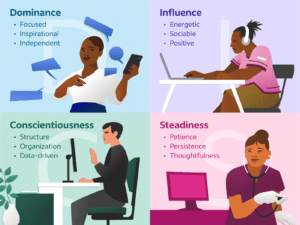
What is the DISC “Compliant” Behavioral Personality Style?
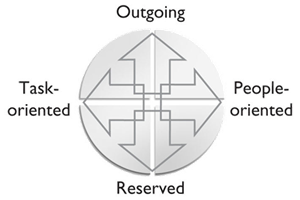
People with the Compliant DISC Behavior Style are Slower-paced and Task-oriented.
Compliant people are accurate, precise, detail-oriented, conscientious, and prefer structure and order. They think analytically, systematically, and carefully make decisions, supported by plenty of research and information.
Compliant people tend to be perfectionistic and have high standards for themselves and others.
Because they focus on the details and see what many other styles do not, they tend to be good problem solvers and very creative people.
Compliant Style Personality Type cross-reference
- Keirsey Type – Guardian
- Temperament Type – Melancholy
- Animal Type – Beaver
- Socio-Communicative Type – Analytical
- True Colors – Gold
- Color Code – White
- Personality Compass – East
- Occupational Type – Realistic
- Learning Type – Pragmatist
- Leadership Type – Avoider
MBTI Personality Types (xSxJ) – Sensing and Judging
Enneagram Types
- Type 1 – The Reformer (All Judging)
- Type 2 – The Helper (ESFJ, ISFJ)
- Type 6 – The Loyalist (All Sensing)
- Type 8 – The Challenger (ESTJ)
What is the DISC Behavioral Model?
The DISC Behavioral Model describes an individual’s characteristics, communication preferences, and motivation as observable behaviors.
Recognizing observable behaviors in others can help you communicate more effectively and build stronger relationships, personally and professionally.
Dr. William Marston theorized that people are motivated by two key motivators that direct human behavioral patterns: the Motor Drive (or Pace Driver) and the Compass Drive (or Priority Driver).
The Motor/Pace Driver
If you divide a circle in half horizontally, the upper half represents outgoing or fast-paced people. The lower half represents reserved or slower-paced people.
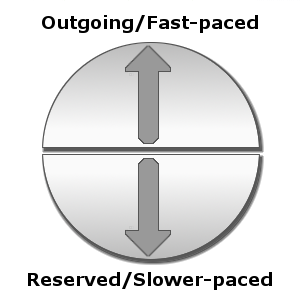
Outgoing people tend to move fast, talk fast, and decide quickly.
Reserved people tend to speak more slowly and softly and generally prefer to consider things carefully and thoroughly before deciding.
Remember that these descriptions of behaviors are tendencies rather than absolutes. Depending on the situation, most people will exhibit a bit of both of these Traits.
Even so, most people will exhibit more of one Trait over the other – even if it is slightly more.
The Compass/Priority Driver
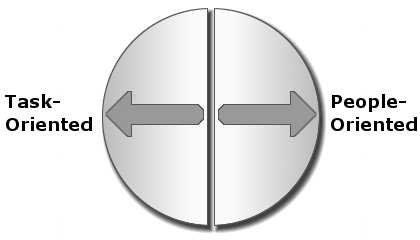
Now, divide the circle vertically. The left half represents task-oriented people, and the right represents people-oriented individuals.
Task-oriented people focus on logic, data, results, and projects.
People-oriented individuals focus on experiences, feelings, relationships, and interactions with others.
The Four DISC Behavioral Styles
When you combine the drawings for the Motor and Compass drives, you get the circle of expected behaviors and perspectives divided into four quadrants.

The DISC circle represents the full graphical description of what is commonly referred to as The DISC Model of Human Behavior.
Each quadrant of the DISC circle has descriptive words attached to it.
These descriptive words attempt to capture the typical behavior traits or tendencies people exhibit with the combination of motor and compass drives corresponding to that quadrant.
They are often called a behavioral type or style to make discussing the quadrants easier.
While using the phrase “personality type” with this model is not strictly or technically accurate from a clinical psychology standpoint, it is often used in everyday conversation.
So, the term Behavioral Style is preferred because it more accurately fits the model and its theory.
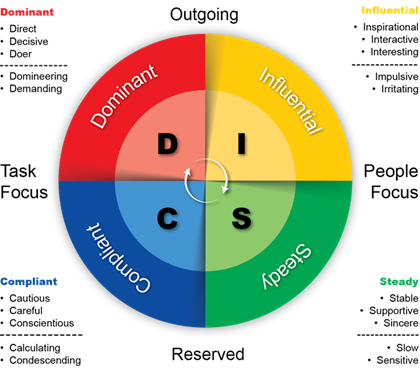
Learn more about the DISC Behavioral Personality Styles.
Personality Temperaments, Traits, and Types
Personality Temperaments, Personality Traits, and Personality Types are used in Psychology to discuss a person’s Personality, a collection of Emotions, Perceptions, and Actions that interact with each other, regulate themselves, and shape a dynamic system that forms a person’s Behavioral Patterns.
Your inherited traits (your personality Temperance) and acquired traits (such as education, socialization, and other various pressures and aspects) form your Personality.
A Personality Type identifies a specific collection of Traits, both learned and natural, that comprise a broad, general Personality Classification—a way of labeling a collection of traits and behaviors.
A Personality Trait remains consistent and stable over time, which means you exhibit the same pattern across different situations and throughout your life.
Three criteria characterize Personality Traits: (1) consistency, (2) stability, and (3) individual differences. For example, if you are talkative at home, you also tend to be talkative at work. And if you were talkative at age 20, you would still be chatty at age 40.
Personality Temperament is your “Naturally Intuitive” biological Trait. These Traits are partly inherited from your genes and partially determined by your brainstem, which doesn’t change throughout your life. These are Natural Traits regarded as innate or inborn and not learned.
Your Personality Temperament is formed as an infant and is hard to modify, manipulate, or change because it is genetic. In some way or another, your inherited behavioral tendency will always be there.
Personality Traits are quantitative differences between people, and Personality Types are qualitative differences between people. The most crucial difference between the Trait Theory and the Type Theory is that the Type Theory views people’s characteristics as discrete categories. In contrast, the Trait Theory views these characteristics as a continuum.
For example, while a Type Theorist would claim that introverts and extraverts are two types of people, a Trait Theorist claims that extraversion is a gradient, and individuals can fall somewhere in the middle.
Your Temperaments, along with acquired Traits, form your Personality.
Traits
- Conservative
- Calculating
- Stable
- Dependable
- Cautious
- Traditional
- Systematic
- Accurate
- Tactful
- Diplomatic
Motivation
- Protection
- Security
- information
- logic
Compliant people are inspired by being well-informed, researching before deciding, having clear parameters and instructions, doing work accurately and correctly, and seeing a project through to the end.
Annoyances
- Incompetence
- Disorganization
- Foolishness
- Dishonesty
- Inaccuracy
- Wastefulness
- Inconsistency
- Blind faith
Under pressure
- Moody
- Critical
- Contemplative
- Negative
- Problematic
Weaknesses
The Compliant Personality Style is one of the passive styles. They will avoid conflict rather than argue; getting them to verbalize their feelings isn’t easy.
They need clear-cut boundaries to feel comfortable at work, in relationships, or to take action.
Sometimes, they can be bound by procedures and methods and find it difficult to stray from order.
And sometimes, they can get too bogged down in the small de
Team Value
Compliant people bring perspective and tend to be the “anchor of reality” to the team.
When something is proposed, they will think through every detail of how it works and the process.
- They will make realistic estimates and voice any problems with the plan or the existing system.
- They will complete tasks they’ve committed to and will be very thorough.
- They take great pride in doing their work accurately and are excellent analysts, researchers, and information testers.
- They are automatic organizers and strive for a logical, consistent environment.
- They evaluate the team’s progress, ask essential questions, and maintain focus on tasks.
- They think logically and work systematically.
- They offer conservative approaches and emphasize quality.
- They are conscientious and diplomatic and will strive for consensus.
- They will also share risks and responsibilities.
Ideal Environment
Compliant people prefer an environment that is peaceful and organized, with few to no conflicts or arguments.
They do not need to be social and are fine working alone.
Compliant people thrive in an environment where they can follow through with tasks and projects to completion.
They excel in specialized or technical functions due to their attention to detail.
They feel the safest when there are procedures and routines and are given instructions and reassurance that they are doing what is expected.
Leadership Style
They tend to lead with a “bureaucratic” approach, delegating authority to others as long as others follow proper procedures.
- They are calculating, and critical thinking demonstrates the unusual ability to motivate others.
- They go by the book, researching and careful not to do anything wrong.
- Their influence on others to follow is often cautious and conservative.
- They don’t make quick or careless decisions.
- They plan their work and work their plan to get others involved in moving ahead.
- Their leadership style is analytical and organized.
Follower Traits
- Analyze each decision.
- They love research and development.
- Quality-oriented followers.
- They don’t like quick or costly decisions.
- Picky and precise, they follow with their minds, not their hearts.
- They seldom responded positively at first.
- Wants time to think about their decisions.
Communication Styles
Compliant People
- Try to be precise, accurate, and sure of your facts.
- Try to be open to suggestions.
- Try to be patient.
- They take time to think carefully before talking and making decisions.
Dominate People
- Try to be relaxed and positive.
- Try to get to the point quickly.
- Don’t bore them with a lot of facts.
- Don’t get defensive.
Influence People
- Be patient and let them talk.
- Get them to talk through the solution.
- Stay on track.
Steady People
- Be sincere and care about what you do.
- Don’t complain.
- Be optimistic and sure of your plan.
Teaching Style
- They make great instructors when sensitive, excited, and patient.
- They determined to discover in-depth truth.
- They can overdo their lessons and become too factual.
- They are competent but dull.
- They can lack enthusiasm and warmth.
- They should focus more on practical application.
- They are critical thinkers and can sound sarcastic.
- They make great researchers.
Learning Styles
Kinesthetic Learner
- Wants to FEEL the lesson is clear and understandable.
- Learns best when communicated through rational and emotional means.
- Desires balance between facts and feelings.
- Wants to learn through heartfelt yet intellectual presentations.
- They need to feel the lesson is logical.
Visual Learner
- They want to SEE the lesson instead of just hearing about it.
- Desires visualization of the facts.
- Learns best when presented with investigated lessons.
- They need to have pictures and charts drawn that explain the task.
Auditory Learner
- LISTENS best to clear and precise words.
- Desires to hear lessons that explain why, what, when, and how.
- Wants to hear competent and accurate communication.
- They are not as interested in the drama but in hearing the facts.
- Learns best with a thorough explanation.

